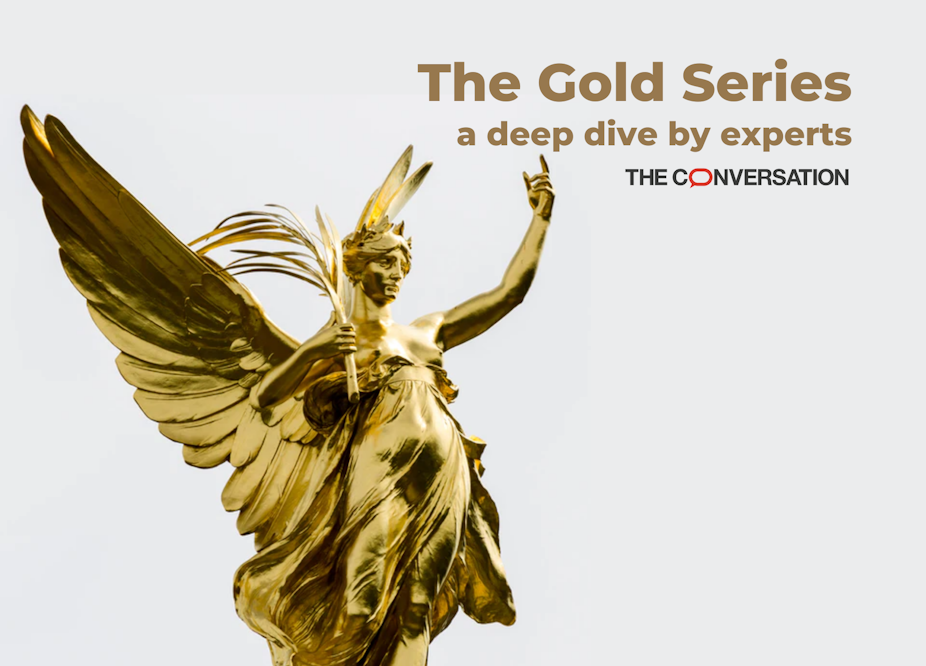Gold has always bewitched mankind. It glows like mysterious sunshine, and never tarnishes or corrodes. It bends to a hammer, turns liquid in a kiln, but glitters for all of time.
The legendary Shang dynasty in China was decorating sculptures and other fineries with gold a thousand years before the coming of Christ. The ancient Egyptians used it to line pharoahs’ tombs; Moses railed at Israelites worshipping golden calves; the Greek hero Jason crossed treacherous seas with his Argonauts in a quest for a golden fleece.
It was the ruin of King Midas, the obsession of the Aztecs, and a unit of account in imperial Rome. The Romans called it aurum, which means “shining dawn”, and survives as Au in periodic tables today.

The ancient Chinese used gold to treat smallpox and ulcers, while medieval alchemists read star charts and built laboratories in the hope of distilling the great yellow metal from lead. In 1840s America, there was so much excitement at its discovery that prospectors emigrated in their hundreds of thousands to the Californian coast.

We still talk of golden ages, golden oldies, gold wedding anniversaries, golden handshakes, and, alas, golden arcs. We put gold medals around our greatest athletes, finish the uniforms of the highest ranking generals with gold braid, and devote endless songs and stories to this magical metal – from Goldfinger to Gold Digger to, er, Gold by Spandau Ballet. “You’re indestructible!”, roared Tony Hadley, and who could disagree.
It’s therefore hardly surprising that gold is still highly important in today’s financial system, and may become even more so in the years to come. The financial crisis of 2007-09 ushered in a period of ultra-low interest rates and aggressive money printing by central banks to try and keep the global system on its feet.
With even greater intervention underway to cope with the COVID-19 pandemic, some say that the amount of money and debt in the system is spiralling out of control. The only solution, they argue, is to redesign the financial system around gold, since it’s finite and trustworthy and can’t be manipulated.

Gold briefings
Time will tell if these doomsayers are right, but in the meantime we wanted to bring you five essential briefings on gold and its place in the modern world:
Why gold prices go up and down – five charts
George Skiadopoulos of Queen Mary University of London kicks off with an explainer on gold’s journey since US President Richard Nixon abandoned the gold standard in the early 1970s. He looks at what moves the price up and down, and how it might fare in the years to come.Countries went on a gold-buying spree before coronavirus took hold – here’s why
In the past decade, many nations quietly shifted substantial amounts of their gold reserves from vaults in London and New York to their own countries. At the same time, a number of central banks began buying gold like it was going out of fashion. Drew Woodhouse of Sheffield Hallam University explains why this happened and what it tells us about the world economy.I’m a bit of a modern-day alchemist, recovering gold from old mobile phones
With gold prices not far from their all-time highs, here’s a little quiz question: what contains more gold, the average ton of gold ore or the average ton of old smartphones? The answer is smartphones, and not by a narrow margin. They contain about 33 times as much gold, not to mention various other precious substances. Sandra Wilson, professor of ecological metal design at the University of Dundee, shows us into the laboratory where she is artist in residence, aka a 21st century alchemist, stirring phones and circuits into cauldrons of acid to see what comes out the other side.Meet the struggling gold miners who are missing out on the boom in precious metals
For all the beauty of gold, it doesn’t look that way when you’re digging for it underground – particularly if you’re one of the many thousands of artisanal miners worldwide prospecting in the darkest corners with little or no government protection. Sara Geenen and Boris Verbrugge of the University of Antwerp tell how these people’s lives are being affected by coronavirus.How the US government seized all citizens’ gold in 1930s
Finally we go on a trip to depression-era America, where economists Chris Colvin and Philip Fliers of Queen’s University Belfast tell the story of Franklin D Roosevelt’s decision to seize the gold of all US citizens in 1933. To compound people’s inevitable outrage, it was seized substantially below the going rate and the government announced a much higher official rate soon afterwards. Could it happen again?
For more news and information you can trust, direct from the experts, subscribe to our newsletter.

